Cite this document
(“Research report on Internet Security Paper Example | Topics and Well Written Essays - 3000 words”, n.d.)
Retrieved from https://studentshare.org/information-technology/1404466-research-report-on-internet-security
Retrieved from https://studentshare.org/information-technology/1404466-research-report-on-internet-security
(Research Report on Internet Security Paper Example | Topics and Well Written Essays - 3000 Words)
https://studentshare.org/information-technology/1404466-research-report-on-internet-security.
https://studentshare.org/information-technology/1404466-research-report-on-internet-security.
“Research Report on Internet Security Paper Example | Topics and Well Written Essays - 3000 Words”, n.d. https://studentshare.org/information-technology/1404466-research-report-on-internet-security.


